Gayle Irwin's Blog, page 8
January 22, 2020
Remembering the Vicktory Dogs
 Almost 13 years ago, in late April 2007, federal authorities executed a search warrant on Virginia property owned by football star Michael Vick after learning about a major dog fighting operation the well-known athlete was running. Dozens of dogs were removed
Almost 13 years ago, in late April 2007, federal authorities executed a search warrant on Virginia property owned by football star Michael Vick after learning about a major dog fighting operation the well-known athlete was running. Dozens of dogs were removedand placed with rescue organizations.
During the past many months, including earlier this week, several of those dogs have passed away. I have followed the journey of many of these incredible canines; in fact, a photo of one who came to live in Wyoming, Little Red, hangs on a wall in my home office.
The Saga
The American Society for the Prevention of
Cruelty to Animals (ASPCA) helped recover and analyze forensic evidence from the property, including carcasses and skeletal remains of numerous
dogs, primarily pit bulls. Ironically, April is Prevention of Cruelty to Animals Month.
That evidence, among others, led to Vick’s indictment in July of felony dogfighting charges. In late August the football player pled guilty under a plea agreement. Two other men associated with Vick pled guilty in November; each was sentenced
to 18 to 21 months in prison. Vick received a sentence of 23 months plus provided approximately $1 million to a fund for the care and rehabilitation of the 47 pit bulls confiscated.
The dogs were placed
with sanctuaries and rescues groups, including California’s pit bull rescue known as BAD RAP and Best Friends Animal Society in Utah. Many were later adopted
after months of care and trust-building. At a time when
most dogs found in fighting operations were considered
evidence
and later euthanized, this explosive, nationally-known
case became the start of finally seeing the animals for what they were (and are): victims. The Vicktory
dogs, as they came to be called
found fighters of the human kind, people who fought to keep them alive and people who fought to show them love and compassion. Although many of the dogs rescued and re-homed have passed away, including Handsome Dan (who had a rescue organization named after him), Cherry (who went from cowering to kisses and recently passed away), Layla (who helped teens understand compassion), and Little Red (
who found a home on the prairies of Wyoming and is pictured
above), their legacy has not passed.
More Victory
Late last year, the U.S. Congress passed a bi-partisan measure making animal cruelty a felony and
t
he
president signed the legislation. Now, not only is dogfighting a felony, but anyone purposefully harming
a dog, cat, horse, or other companion animal can be guilty of a felony, not just a misdemeanor. Because of this case, and many, many others, the United States finally officially recognizes the value of companion animals and the immense harm that’s been inflicted
on them physically and emotionally and seeks to do something to
prevent that – and make an example of those who abuse.
Thanks to the many people who took a chance and took compassion on the dogs that Michael Vick and many others abused, tortured, and even killed, those dogs whose lives were spared
lived their remaining years knowing only kindness and care. And today, more such dogs, those who are rescued
from fighting operations, and other creatures who have only known pain and suffering have a fighting chance to not only survive, but to thrive.
For More Information:
Read a lengthy, inspiring article with photos about the dogs here:
https://www.washingtonpost.com/graphics/2019/sports/michael-vick-dogfighting-dogs/
Several books have been written
about the Michael Vick dogs, and an award-winning documentary film created. Learn more about these artistic creations here:
The Champions documentary film: http://www.championsdocumentary.com
The Lost Dogs by Jim Gorant
and The Found Dogs by Jim Gorant
https://www.amazon.com
/dp/B0052RHGNU/ref=dp-kindle-redirect?_encoding=UTF8&btkr=1
Listen to a four-minute audio accounting of the Michael Vick dogs and what has been learned
since at this National Public Radio link:
https://www.npr.org/2019/09/26/764790714/what-happened-to-the-dogs-in-michael-vicks-dogfighting-operation
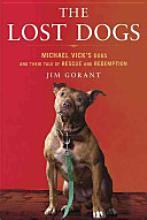
Published on January 22, 2020 20:08
January 14, 2020
book review - no kidding in love
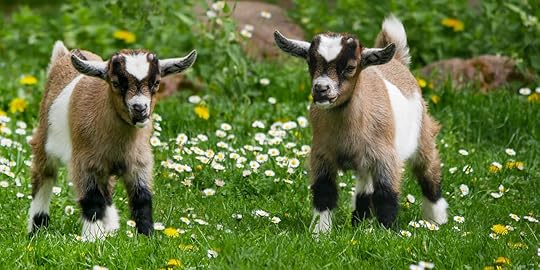 A millionaire businessman. A vegan, animal-loving personal assistant. A small town called True Love. When you mix these three ingredients together, you have a clean, contemporary “Animal Sanctuary” romance novel written by Eliza Boyd.
A millionaire businessman. A vegan, animal-loving personal assistant. A small town called True Love. When you mix these three ingredients together, you have a clean, contemporary “Animal Sanctuary” romance novel written by Eliza Boyd.No Kidding in Love is Boyd’s second installment of her Animal Sanctuary romance series. (I posted about her first book in the series, A New Leash on Love , a few months ago). I enjoyed her first book in that series so much, I was excited to read the second book (
due to my own
novel
’s release in November, I had to postpone reading and reviewing Boyd’s)
. Now that I’ve had time to complete No Kidding in Love, I’m happy to report I enjoyed her second book, too.
Different primary characters than found in A Leash on Love (although some characters from the first book migrate to this one), and a focus on farm animals (primarily goats), this story weaves humor and love for animals into a romance story involving a millionaire (Trent) reluctant to become involved with any woman due to heartaches he experienced years before. His personal assistant, Macy, however, has been secretly in love with the man for years. She, too, experienced loss prior to coming to work for him. However, Trent’s gentlemanly manners, his brilliance in business, and his kind family of origin make their mark upon Macy’s heart. Can she continue to keep her secret as the two travel to True Love, Arizona, where, once again, they spend a week with his family and she begins volunteering
at
the Animal Sanctuary? Can he continue to push his own feelings for her away as they spend more time together in a town known to bring couples together?
Boyd’s characters are likeable (although I admit to becoming frustrated with Trent). Of course, I
LOVE the animal sanctuary concept, and bringing goats into the story versus the usual dogs and cats is unique and fun! (especially talking about the baby goat!) And weaving Macy’s skill of event planning to help raise funds for the sanctuary is an added
bonus – she’s not just a rich guy’s personal assistant!
Boyd has authored many clean romance books – it’s definitely “her jam!” She writes about small towns and about billionaires. I’m sure I’ll be adding more of her work to my “to-read” list this year.
For a delightful, clean romance read this winter or during February (Valentine’s Day!!), pick up a copy of Eliza Boyd’s No Kidding in Love. If you love clean romance, fun characters, and rescue animals, you’ll enjoy this book. No kidding!
Available in both print and e-book from Amazon:
https://www.amazon.com/No-Kidding-Love-Romance-Sanctuary-ebook/dp/B07VC9WMVT/ref=sr_1_10?keywords=eliza+boyd&qid=1579012867&s=books&sr=1-10
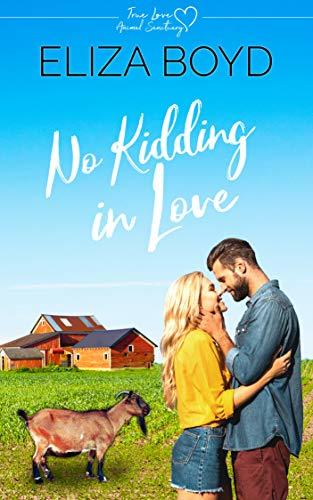
Published on January 14, 2020 11:02
January 6, 2020
training your pet benefits both animals and people
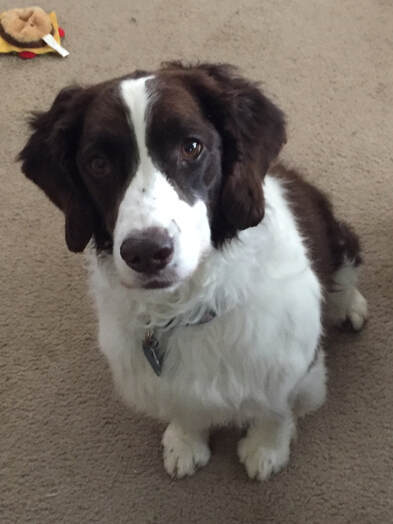 She’s a counter surfer and has stolen enough bread, chicken, and other foods from the kitchen to feed several people at our local rescue mission. She jumps on people and pulls on the leash. Her name is Sadie, and we adopted her last September. He barks when we eat dinner. He doesn’t come when I call him and he only sits when he wants to, not when I ask. His name is Jeremiah, and we’ve had him for more than two years. Both of our dogs need corrections to their behavior …
She’s a counter surfer and has stolen enough bread, chicken, and other foods from the kitchen to feed several people at our local rescue mission. She jumps on people and pulls on the leash. Her name is Sadie, and we adopted her last September. He barks when we eat dinner. He doesn’t come when I call him and he only sits when he wants to, not when I ask. His name is Jeremiah, and we’ve had him for more than two years. Both of our dogs need corrections to their behavior …and stubbornness. Yes, both dogs had lives before their adoptions, lives that were unstable and unkind. Yet, our neglect of training has not alleviated
bad behaviors. My husband and I resolve to change that in 2020.
Welcome to a New Year! With each calendar roll into January comes pledges for new goals and resolutions, especially when people think of their health. This month is also designated
as a special month for pets and their people: it’s National Train Your Dog Month.
Started by The Association of Professional Dog Trainers (APDT), this unique designation reminds pet owners of the many benefits of trained pet, including bonding with the owner, positive behavior around guests, and safety. From counter surfing to lack of control on a leash or voice command, untrained animals run the risk of eating things that will make them sick, or worse, and of being run over by a car, among so much more. Jumping on people, barking incessantly, and chewing on shoes are behaviors not welcomed by guests, neighbors, and household members. Therefore, curbing these traits with training keeps your friends friendly.
Brandon McMillan, celebrated celebrity dog trainer, pet rescuer, and host of the CBS Saturday program “Lucky Dog,” teaches animals seven basic commands: sit, stay, come, no, off, heel, and down. He says, “Instead of teaching my dogs 20 commands that they might not be great at, I teach them to be perfect at the 7 most common commands you say on a daily basis….” McMillan authored a book titled, Lucky Dog Lessons: Train Your Dog in Seven Days. I purchased this book for my husband as a Christmas gift; we both need to read it – and put the lessons into practice.
A dog trained in the seven basic commands as outlined by McMillan on his show, on his website, and in his techniques will be a dog that is well-behaved at home, in public, and while traveling. S/he will be a dog welcomed by hotels, vacation home rentals, and your in-laws (or sister, brother, cousin, parents, friends). Your dog will be safer by coming when called; you’ll enjoy dinner more often without a beggar or barker; and you’ll not worry about the next holiday meal served in your house – the food will remain on the counter instead of being swallowed by your untrustworthy canine. A deeper bond will develop between you and your furry friend as you share more time together.
Dogs aren’t the only pets that can be trained. Rabbits learn to use a litterboxand cats learn to come when called. One blogger trained her cats to do agility. For cat training tips, visit this blog post from Hill’s Pet Foods:
https://www.hillspet.com/cat-care/training/cat-training-the-easy-way.
As this New Year goes into full swing, engage your pet in some mental as well as physical
exercise through training. You’ll both benefit in many different ways.

Published on January 06, 2020 14:19
December 31, 2019
A New year, a new decade!
 A new year begins. So does a new decade. Celebrations begin. Don't let the joy of ringing in this newness end with tragedy. Your pets may be frightened by the festivities
A new year begins. So does a new decade. Celebrations begin. Don't let the joy of ringing in this newness end with tragedy. Your pets may be frightened by the festivities, the noise, the people; therefore, remember two very important parts of your New Years
' celebration: quiet and identification.
Your pet should be safely contained
in a quiet area of your home. Provide his/her special bed/blanket, some food and water, and toys to help occupy and distract your pet from all the commotion. Fireworks, alcohol, noise makers
, and other disturbing sounds can cause panic and anxiety in your animal. Therefore, having his/her own quiet refuge will not only ease the stress,
but also keep your dogs and cats safe at home.
However, in case your pet slips out the front door or the backyard gate, make sure s
/he is microchipped
and/or has an ID tag on the collar. And,
ensure your contact information is updated. These tips are vital to make sure your pet gets home more quickly.
The ASCPA and others offer other great safety tips for New Year's Eve/New Year's Day celebrations. Visit these websites to learn more:
https://www.aspca.org/news/celebrating-safely-ringing-new-year-your-pets
https://www.fox10phoenix.com/news/new-years-eve-pet-safety-tips-to-keep-your-four-legged-friend-safe-during-celebrations
Happy (and Safe!) New Year to you and all your family and friends, including those beloved furry ones!!

Published on December 31, 2019 05:50
December 19, 2019
Keep Christmas Safe for your furry friends!
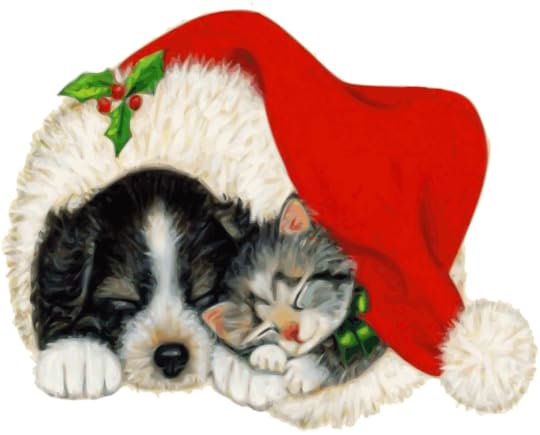 "May your days be merry and bright ..." So goes the Christmas song. Keeping our pets safe during the holiday season is one way to ensure our Christmas and New Year's are more merry and bright.
"May your days be merry and bright ..." So goes the Christmas song. Keeping our pets safe during the holiday season is one way to ensure our Christmas and New Year's are more merry and bright.Did you know many holiday decorations, food, and festivities can harm our beloved pets? Tinsel attracts cats, and they can swallow this sparkling streamer, which can be life-threatening. Many types of plants seen in homes during this time of year are also harmful,
including lilies, mistletoe, and holly. If you have a live tree, don't leave water standing - bacteria can build up and if your pets drinks from that well, the result will not be pleasant ... for either of you. Food such as chocolate, alcohol, garlic, and other spices should be avoided by your furry friends
. Additionally, guests
coming and going and
noise from New Year's celebrations can cause stress and fear. At times, pets
escape the home and become lost or are run
over. Avoid such a tragedy by setting aside a special room for your furry friend to relax and enjoy a special toy of his/her own and have peace and quiet
.
The infographic below, provided by PetCareRx
, showcases many of the potential holiday spoilers. Keep Christmas happy for you and your furry friends by keeping them safe!
For more safety tips during this season, visit this website:
https://www.aspca.org/pet-care/general-pet-care/holiday-safety-tips
MERRY CHRISTMAS AND HAPPY NEW YEAR TO YOU AND EVERYONE IN YOUR FAMILY! Perhaps take time to slow down and enjoy a few good movies as a family, including the four-footed ones!
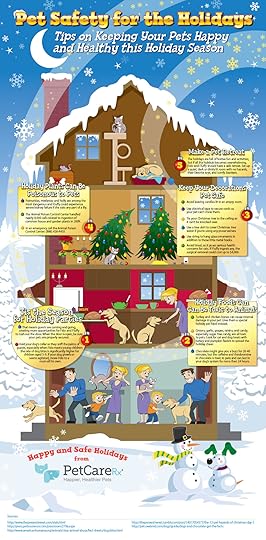
Published on December 19, 2019 10:02
December 10, 2019
pet-oriented movies to watch with your family
 Snow outside, cozy inside - what's better than watching a movie on a winter's day (or night)? During the upcoming holiday break, you and your family (or you and your friends, or just you!) might want to take a day or two (or night
Snow outside, cozy inside - what's better than watching a movie on a winter's day (or night)? During the upcoming holiday break, you and your family (or you and your friends, or just you!) might want to take a day or two (or nightor two) and curl up with some family-friendly, delightful, entertaining, and sometimes inspiring movies that feature animals. There are many from which to choose! Here’s a sampling (and not in any order of good to
bad, just a few ideas):
The Secret Life of Pets 1 & 2 A Dog’s Journey Charlotte’s Web
101 Dalmatians Homeward Bound Babe
Lady and the Tramp Milo and Otis Garfield The Movie
Because of Winn Dixie Benji G-Force
Many of the above movies are available on DVD or via streaming services. Find a more extensive list here: https://www.ranker.com/list/best-animal-movies-for-kids/dad-of-the-year
How about a movie with your sweetheart? Hallmark has plenty of romantic movies that include pets. Here are a few, including some that are Christmas-oriented:
Love at First Bark
Eat, Play, Love Like
Cats and Dogs
Walking the Dog Love to the Rescue Love and Sunshine
The Christmas Shepherd You Lucky Dog Unleashing Mr. Darcy
A Dog Walker’s Christmas Tale A Veteran’s Christmas Love Unleashed
Some of these are available as DVDs, some are available through streaming services, and some (especially the Christmas-oriented movies) are running on Hallmark Channel and Hallmark Movies & Mysteries this month!
Happy Binge-Watching!
--------------------------------------------------------------------
"It's a Hallmark movie in print." That's what one reader, who is a bookstore owner, said about my new clean, contemporary romance novel, "Rescue Road." A story about second chances, the book brings together freelance writer and dog rescuer
Rhiann Kelly and EMT captain Levi Butler. If you're still shopping for Christmas gifts, or are looking for a holiday read for yourself this season, "Rescue Road" just might be what you're looking for! Available through
Amazon on Kindle for just .
99 cents for this month and available in print format for $11.99. A portion of all my book sales is donated
to pet rescue organizations, so buy a book and help pets in need!
Click this link to go to my Amazon page:
amzn
.
to/2W7fpBe

Published on December 10, 2019 07:12
December 3, 2019
When does animal abuse end?
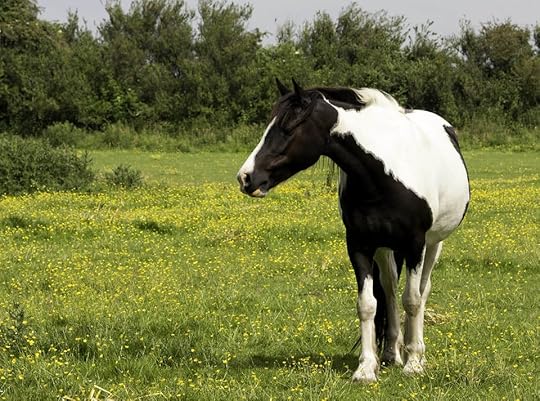 This fall, a bipartisan endeavor brought forth a bill making animal cruelty/abuse a felony. The U.S. Senate passed the measure unanimously, as did the House earlier, and President Donald Trump signed the bill into law. Known as the PACT (Preventing Animal Cruelty and Torture) Act, the measure closes loopholes in a 2010 law incorporates torture and other forms of cruelty. Violators now face penalties of fines, prison terms of up to seven years, or both.
This fall, a bipartisan endeavor brought forth a bill making animal cruelty/abuse a felony. The U.S. Senate passed the measure unanimously, as did the House earlier, and President Donald Trump signed the bill into law. Known as the PACT (Preventing Animal Cruelty and Torture) Act, the measure closes loopholes in a 2010 law incorporates torture and other forms of cruelty. Violators now face penalties of fines, prison terms of up to seven years, or both.This week, I’m pleased to welcome a guest blogger to my site. Karen Ingalls is an award-winning author, blogger, and a retired RN with a Master’s Degree in Human Development/ Psychology. She recently released a new book which deals with a tough subject: abuse. She’s graciously provided this post to talk about one such form: animal abuse/cruelty. It’s a tough subject but one that needs to be addressed
, for sadly, animal abuse, just like child, elder, and spousal abuse, happens all too frequently. Welcome, Karen!
****************************************************************************
by Karen Ingalls
Unfortunately, animal abuse has been around for thousands of years. Throughout history there have been animal sacrifices and animal cruelty. The ritual of killing and offering an animal was a religious ritual in Europe and the Near East until Christianity spread during the Middle Ages. (source: en.wikipedia.org/wiki/Cruelty_to_animals)
The cruel and abusive acts by humans fall into the categories of dogfighting, the puppy industry, animal hoarding, farm animal welfare, horse slaughter, and such “sports” as Greyhound racing and cockfighting. Animal neglect includes lack of shelter, food/water, mange, and cages if too small. (source: https://www.humanesociety.org/resources/animal-cruelty-facts-and-stats )
My experience with animal cruelty occurred when I was a young teenager. I had always loved horses, and my favorite book was titled Drinkers of the Wind. My stepfather bought three horses: a stallion for him, a Shetland for my seven-year-old sister, and an American Paint for me. This was very kind and generous of him; however, his kindness soon proved to be false. My horse was namedBabe and his previous owner had abused him by frequently poking him with a pitchfork and keeping him locked up in a stall for several days at a time.
My parents were concerned if I would be safe riding or caring for Babe, but I never had an issue with him. He let me brush him, ride him, and he always obeyed my commands.
When any male was round, Babe snorted, flared his nostrils and pawed the ground.
One Sunday, my stepfather wanted to ride my horse. I cautioned him that Babe did not like men and it would not be a good idea to try and ride him. His response was a glare and said that I had spoiled Babe long enough. My stepfather barely managed to get in the saddle. Then he started whipping and kicking my beloved horse who suddenly took off on a dead run. After some distance, Babe came to a sudden halt, and I watched my stepfather fly over the horse’s head and land hard on the ground. My stepfather’s dark glare, swearing and “I’ll show your horse who is boss,” scared me.
The following Sunday, I eagerly looked for Babe in the stall, corral, and pasture. With an evil smile my stepfather told me, “You will not find your stupid horse here. I sold him to a dog food factory.” I was devastated, hated my stepfather, and never rode a horse again.
My stepfather physically, emotionally and sexually abused my mother, sisters, and me. He was 32 when he married my mother, and he was in his early 40’s when he had my horse killed. He tolerated the parakeet and dog we had but never participated in their care. I often wonder what he did to our pets when we were not home.
Writer’s and Editor’s Notes: Oftentimes there’s a relationship between animal and human abuse. Women who have been abused report their husbands or significant others did the same to their pets. Men under 30 are more likely to abuse animals, but animal hoarding occurs more commonly with women over 60.
(source: https://www.humanesociety.org/resources/animal-cruelty-facts-and-stats ). Report abuse of any type, to another person or to an animal, to the proper authorities. There is help for both!
Bio:
Karen Ingalls writes about abuse of all types in her newest book, When I Rise: Tales, Truths, and Symbolic Trees, a series of short stories that center on social and family issues. The book is available on Amazon in print and Kindle formats: https://www.amazon.com/When-Rise-Tales-Truths-Symbolic/dp/1706761953. She is the author of award-winning books, a blogger, an active member of Rave Reviews Book Club, Rave Writers International Society of Authors, and Independent Authors Network. She likes to write about family and social issues, many of which she has personally witnessed in her family. Ovarian cancer has been a part of her life for the past several years, but “it does not have my life.” She advocates for ovarian cancer awareness, is a public speaker, and fundraiser. By birth she is a Californian, her heart is in Minnesota, and she is a happy retiree playing golf, gardening, and writing in Florida. She loves to read and challenges herself to read 100 books each year, but writing is her true passion.
Books:
When I Rise: Tales, Truths and Symbolic Trees
https://www.amazon.com/When-Rise-Tales-Truths-Symbolic/dp/1706761953
Outshine: An Ovarian Cancer Memoir
https://www.amazon.com/Outshine-Ovarian-Cancer-Karen-Ingalls-ebook/dp/B00KI1HGZI/ref
Davida: Model & Mistress of Augustus Saint-Gaudens
https://www.amazon.com/Davida-Model-Mistress-Augustus-Saint-Gaudens-ebook/dp/B01DA963A8/ref
Novy’s Son: The Selfish Genius https://www.amazon.com/Novys-Son-Selfish-Karen-Ingalls-ebook/dp/B01B1O2VQY/ref
All book sale proceeds go to ovarian cancer research!
Karen Ingalls on the web:
Website/blog: http://kareningallshome.Wordpress.com
Twitter: @KIngallsAuthor
Pinterest: http://www.pinterest.com/kcingalls
LinkedIn: https://www.linkedin.com/feed/?trk=404_page
Facebook: https://www.facebook.com/Karen-Ingalls-1473379352893458/
Goodreads: http://goodreads.com/kareningalls
Book video for Davida: https://www.youtube.com/watch?v=FNLHvrnlqRY&feature=youtu
Book video for Novy’s Son: http://bit.ly/2jJmMwl

Published on December 03, 2019 04:00
November 26, 2019
Keep Your Pets Safe This Thanksgiving
 Americans celebrate Thanksgiving this week, and that generally
Americans celebrate Thanksgiving this week, and that generally means lots of food, plenty of decorations, and much activity. People can stress during this time of year, and so can our pets. To enjoy a better holiday, especially regarding our beloved animals, here are a few safety tips:
With the door opening and closing due to
guests in
the home, ensure your pet has a safe area, whether that’s a room with toys, food and water, and a bed, or a crate with the same. Keeping your dog or cat confined while people are in and out of the home will prevent your pet from escaping and get lost/locked outdoors.Make sure your pets are wearing ID and/or are microchipped
in case they do
escape.Keep plants and flowers out of reach. Many species of plants and flowers are toxic to dogs and cats (see a list at the ASCPCA’s website: https://www.aspca.org/pet-care/animal-poison-control/toxic-and-non-toxic-plants). Therefore, it’s best to not buy these and to keep all flowers and plants out of your animal’s reach (which can be difficult if you have cats that climb).Thanksgiving decorations can pose a danger to pets. If you have a chewer, like a puppy, make sure electrical cords are protected against exploring teeth. Also, candles can be knocked over
, causing a fire. Therefore, keep a close eye on these, or better yet, use battery-operated candles for that festive flair and put your mind at ease that flickering candles won’t spoil Thanksgiving.Be mindful of human foods that can harm pets. Thanksgiving feasts tempt all of us with delicious aromas and tastes; our pets are also tempted
, and we may be tempted
to feed them from the table or after dinner. However, there are many human foods which are toxic to dogs, cats, and other pets. Some of those include: grapes, raisins, onions, garlic, nuts, and yeast dough. Find more here: https://www.aspca.org/pet-care/animal-poison-control/people-foods-avoid-feeding-your-pets
Below is an infographic created by a veterinary clinic with more food safety tips for this week’s holiday.
If you believe has been poisoned
by food or plants or something else, you can contact the ASPCA’s Poison Control Hotline: (888) 426-4435.
May you and your family and your pets enjoy a safe, blessed and happy Thanksgiving!
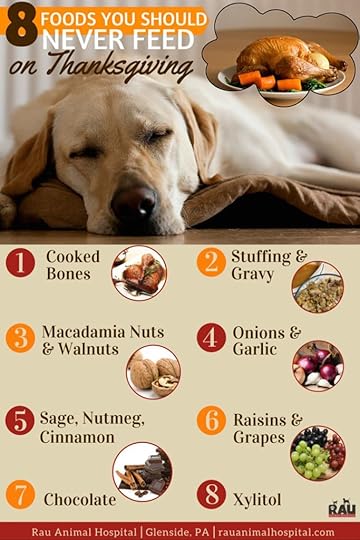
Published on November 26, 2019 05:00
November 19, 2019
Community Cats Need Care Too
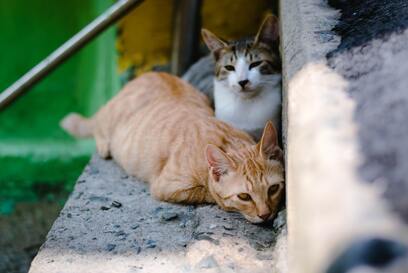 They are despised
They are despisedby some and often killed. Yet, the presence of
feral
/stray cats on farms, ranches, abandoned buildings, and urban alleys often starts with the abandonment of someone’s pets. These animals are usually not spayed or neutered, and therefore, populations multiply and go unchecked. However, there are solutions to curb feral cat populations without lethal means and to care for them in compassionate
, mutually-beneficial
ways.
Trap-Neuter-Return (TNR)
This humane approach to addressing feral cat issues, particularly breeding, not only saves cats’ lives but also addresses community concerns. What is TNR? Cats are humanely trapped
, taken to a veterinarian, spayed/neutered, vaccinated for rabies and other diseases, ear-tipped (this is the way to know if a cat is part of a TNR program), and returned to their outdoor community.
This program began in the United Kingdom., and in 1990, the non-profit Alley Cat Allies formed in the United States and began implementing the project. Such a program “improves the co-existence between outdoor cats and humans in our shared environment,” according to the organization.
Learn more about Alley Cat Allies and TNR by watching this short video: https://youtu.be/A14ZH-RSdKo
The American Society for the Prevention of
Cruelty to Animals (ASPCA) also supports TNR and other methods of working with feral cats. Read some of their ideas here: https://www.aspca.org/about-us/aspca-policy-and-position-statements/position-statement-community-cats-and-community-cat
Feral Cats, Birds, and Other Animals
Even though songbirds can be killed
by stray/feral cats, a bird is harder to catch than a mouse. Just as a bobcat or lynx stalks a rabbit for its meal, cats that live outdoors or in a barn are beneficial for keeping rodent populations, like mice, which spread disease to humans, to a minimum. During times of ships crossing the ocean, seafarers employed
cats for just that purpose, and farmers and ranchers to this day have cats on hand to keep down the mouse and rat populations.
Friends of mine own a ranch about 75 miles from where I live. They welcome the stray cats which come onto their property. They feed them and whenever possible,
capture
them humanely, take them to the vet for spay/neuter and vaccination, then release them back on the ranch. Their barns and outbuildings have less
mice
because of these cats. I have rarely seen a dead bird on their property, and my friends even put out feeders for the songbirds; therefore, they aren’t concerned
about the feral cats killing birds.
One of the stray cats they discovered a few years ago had been someone’s pet for she was/is super friendly and even declawed. She is now their house pet, although she is allowed
outdoors on occasion
. I wrote a short story about “Fancy the Farm Cat” that I’m happy to share with you; just a leave a comment on this blog post.
Read a comment from Alley Cat Allies regarding bird and animal predation by feral cats here: https://www.alleycat.org/alley-cat-allies-statement-about-journal-of-conservation-biology-article/
Help for Community/Stray/Feral Cats
During my travels, I've visited two small towns, one in Wyoming and the other in Oregon, where community cats were cared
for and TNR programs were implemented
. People and town governments can work together, alongside local and national cat advocate groups, to help reduce populations of feral/stray/community cats and do so in humane and compassionate, non-lethal ways.
Best Friends Animal Society provides resources for those who desire to help stray cats in their community. They also run successful program partnerships with other animal welfare organizations in Utah, where Best Friends is based
. Learn more about these endeavors here: https://utah.bestfriends.org/our-programs/communitycats
As the ASPCA notes, “Community cats exist because of generations of human action and inaction, therefore humanely addressing the needs of these cats and implementing programs which help prevent their reproduction, are the responsibility of the communities in which they live. The ASPCA encourages cat advocates, animal shelters and rescues, local government officials and the public to work together….”
To receive a free copy of my short story “Fancy the Farm Cat,” please leave a comment and your email address.
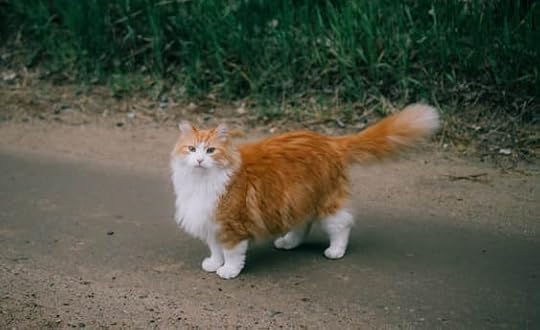
Published on November 19, 2019 12:17
November 12, 2019
Finding a Place in Pet Rescue
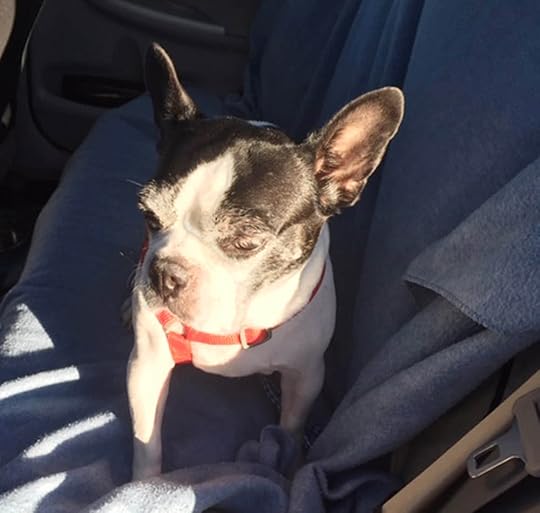 Her name was Maggie, and she needed a ride home. I offered to take her part-way, so on Friday, November 8, we hit the interstate. I volunteered to drive her 180 miles south, getting her closer to home, and another driver graciously took the remainder
Her name was Maggie, and she needed a ride home. I offered to take her part-way, so on Friday, November 8, we hit the interstate. I volunteered to drive her 180 miles south, getting her closer to home, and another driver graciously took the remainderof the route. Maggie, a senior Boston terrier mix, arrived safely into the arms of her adoptive person.
Each of us found a place in rescue
that day: two of us as volunteer transporters; Maggie, of course,
being rescued; and her adopter. That’s the case with all animal rescue; people and the pets each have a role, a place, in the process
.
I’ve transported for rescue organizations for more than a decade. In Wyoming, where I live, distance between towns can be extensive, sometimes as much as 50 miles or more from community to community. There’s a gap to be filled
in getting many dogs and cats into rescue and into the homes of new families. I fill that void whenever possible
for whatever rescue organization needs a driver.
Theo, another Boston terrier I transported several years ago, seemed in-tune to what was transpiring the day I took him 150 miles from my community north to another Wyoming town. He stretched his small body from the passenger seat toward the window. His round, black eyes surveyed the landscape as my car zipped along the interstate. Curiosity kept him attentive to the passing grass, trees, and spring wildflowers. Yet, something else seemed to stir within the dog. As I slowed the car to the posted town speed limit and approached the second exit that would take us to a rest stop, Theo leaned closer to the dashboard. His front paws balanced there before I could place a protective arm across his chest. He watched intently, and I drove slowly. As we rounded the corner into the parking area, his ears peaked and his eyes stared. Waiting for us at the end of that drive were his adoptive pet-parents. He just seemed to know.
Volunteering as a transporter is a critical piece of the rescue puzzle, and I derive great joy from fulfilling this position. Knowing a companion animal is getting another chance to be loved
and doted upon just as I care for and spoil my own adopted pets makes those treks worthwhile. I’ve taken many breeds of dogs on journeys home, and I love doing so!
There is a place for many in pet rescue. Whether you set up an organization, as my friend Britney did with Black Dog Animal Rescue in Cheyenne, Wyoming, volunteer as a foster parent as Joel and his wife Karen in Denver do (they fostered our latest adopted dog, Sadie), serve as a transporter like me, or adopt a pet as many of us have, each place in the system is necessary. What about you? What role can you play to help animals in need? Perhaps help at fundraising events. Donate supplies or
money. Volunteer to walk and play with dogs or brush and play with cats. Serve as a foster
. Transport. Adopt. Help educate and spread the word.
I aim to educate and inspire through my writing. Whether that’s blog posts like this one, a children’s book such as Jeremiah Finds a Home , or my new novel, my writing also has a role in rescue.
Rescue Road, my contemporary romance novel released last week, incorporates the concept of rescue, including setting up a facility and transporting dogs. The story weaves the idea of
second chances, not only for the animals in need of new homes but second chances for the primary characters who fall in love. Life is all about second chances, and we all need that now and then, just like rescued pets.
Animal rescue takes a village. No matter where we live, we can help animals in need. Will you join in this special cause and find your place in pet rescue?
My clean, contemporary romance novel is now available in e
-book or print format. Learn more, including viewing a book trailer and downloading the first chapter for FREE on my website: http://www.gaylemirwin.com/novels.html.
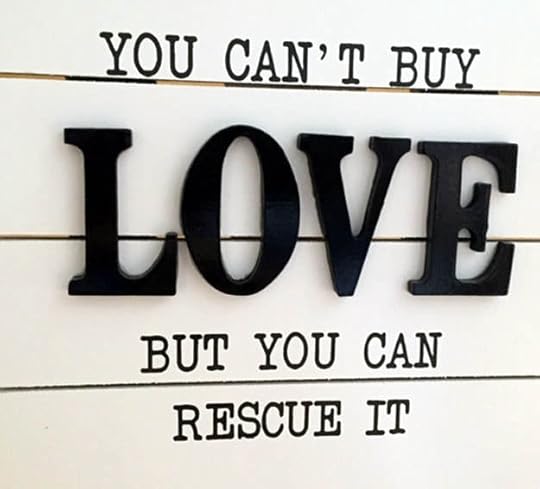
Published on November 12, 2019 07:10



